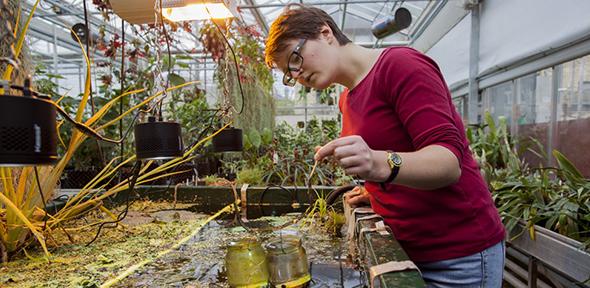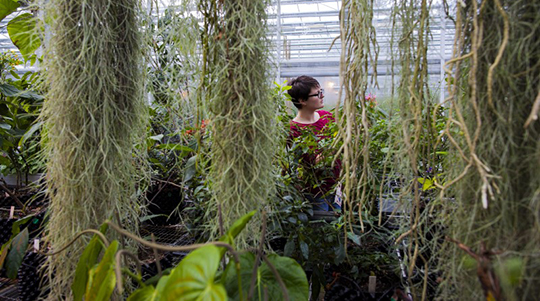
She discovered a love of growing things in an overgrown corner of her parents’ Scottish garden. Now, she’s mastering botanical names and important practical skills at the Botanic Garden. Bryony Langley, a trainee horticultural technician, delights in...
There are over 8,000 species from all over the world in the Garden. Being a trainee provides a wonderful opportunity to discover where your interests really lie.
Bryony Langley, trainee horticultural technician in the Botanic Garden
I’m one of seven horticultural trainee technicians on this year’s Botanic Garden programme. We’re a varied group in terms of background and age — and there’s a strong sense of shared endeavour. Several of us are new to Cambridge and some are making complete career changes.
The Botanic Garden has been serving researchers for 171 years. Engineers, chemists, biologists and botanists (to name a few) have used the plant collection at the Garden for their studies. It’s amazing to work somewhere that is pushing the boundaries yet so steeped in history. This is where Darwin was taught botany by John Henslow, through whom he got a position on HMS Beagle. Much of the old half of the Garden is still laid out as the curator Andrew Murray planned in 1845.
Plants make me smile. They are so perfectly adapted to their environment, sometimes in the weirdest of ways, that I can’t help but admire them. I love Tillandsia usneoides (Spanish Moss) and Dahlia imperialis for being not quite as we would expect. One of my favourite gardens is Ascog Hall on the Isle of Bute in Scotland. Its Victorian sunken fernery is full of arching, floppy ferns. The garden above spills over with clashing colours and strange plants down hidden paths.
Plant knowledge is everything. There’s an incredible amount to learn. It’s a question of deciding which aspects you’re most interested in and what direction you want to take. There are over 8,000 species from all over the world in the Garden. Being a trainee provides a wonderful opportunity to discover where your interests really lie. We’re taught the skills we need to work as technicians — from how to mow the lawn to propagating from seeds and cuttings.
It’s vital to know the botanical names. Like most people, I didn’t do Latin at school but have had to get to grips with the botanical names for plants. Common names can be confusing as they can change depending where you are in the country, but botanical names are international. So I grapple with names such as Aglaomorpha drynarioides or Xanthophthalmum coronarium.

The traineeship programme has practical and theoretical elements. It’s hands-on rather than academic, but we do have tutorials and essays to do as well as plant identification. Before coming here, I did a two-year apprenticeship at RHS Garden Rosemoor in Devon. My boss, an ex-trainee himself, recommended the traineeship here as the next step towards a career in horticulture.
After deepest Devon, Cambridge is a bustling metropolis. I’m getting to know the city and it’s a huge treat to be able to go to a film or jump on a train to London. I love the medieval streets around Great St Mary’s Church — and the bridges over the river.
Reversing a tractor and trailer is tricky — especially if you’re backing into a tight space or round a corner. It’s a skill you need if you’re hoping to work in a big garden. Everyone finds it hard at first but it’s a great feeling once you’ve mastered it.
An outdoor job is physically demanding. When I was a teenager, if you’d suggested I might like to work in all weathers, I would’ve laughed. It can be tough when you’re weeding in the driving wind and rain. Of course I moan, but the rain is generally very helpful in the Garden — especially here in the east of the country.
I got the gardening bug in my parents’ garden in Stirling. After a degree in Biology followed by a postgraduate course, I was unsure what to do. I went home to my parents and got a job in a café. The back garden was a bit neglected and as they were trying to sell the house, I thought I’d tidy it up. The vegetable patch alone took three days to clear — trees had started growing in it. I planted the garden with Lobelia ‘Queen Victoria’ and the ‘obedient plant’ Physostegia virginiana. There’s nothing like fresh veg or the excitement of huge hollyhocks from forgotten seed.
For me, gardens are for sharing. I’d like to work in a garden that’s open to the public and where, like here, there are opportunities to engage with people of all ages to get them excited about plants. I feel incredibly fortunate to have found something I love doing. Gardening is comforting and deeply satisfying as well as inspiring and exciting.
This profile is part of our This Cambridge Life series.
